A ‘forest’ has sprung up in an unlikely location in London

Traditionally, London’s Somerset House has operated a strict no trees policy. If it had leaves, it wasn’t allowed in – those were the rules, as laid out by the building’s founders.
However, in what amounts to a remarkable u-turn, the venue has become the unlikely location for a 400-tree forest, which has sprung up in the Neoclassical courtyard for the month of June.
The forest is the centrepiece for this year’s London Design Biennale. The event seeks to highlight the role that design can play in building a more resilient and inclusive future in a world impacted by climate change and inequality. It runs until 27 June.
Es Devlin, the biennale’s artistic director, came up with the idea for the forest after learning about Somerset House’s no trees policy.
“When I was first shown around Somerset House many years ago, I discovered that the Enlightenment principles on which the building was conceived, specifically forbade the introduction of trees into the courtyard,” she said.
“Of course, the first thing we wanted to do when considering this year’s biennale was to counter this attitude of human dominance over nature, by allowing a forest to overtake the entire courtyard.”
In literature, Devlin noted, forests are often depicted as places of transformation: the forest of Arden in Shakespeare, the enchanted forests of the Brothers Grimm. She had the same vision for the Forest of Change, which contains a clearing where visitors can learn about the UN’s sustainable development goals: global targets that seek to transform the world into a fairer, safer and more sustainable place.
However, it’s Design in An Age of Crisis that offers perhaps the greatest scope for inspiration. The exhibition showcases potential solutions to pressing global problems, as submitted by designers all over the world.
Sir John Sorrell CBE, president of the London Design Biennale, said: “Great design ideas can help change things for the better, inspire people and give them hope for the future – never more needed than now. The London Design Biennale will present inspired thinking from across the world in a unique exhibition designed to entertain, inform and spark action.”

Traditionally, London’s Somerset House has operated a strict no trees policy. If it had leaves, it wasn’t allowed in – those were the rules, as laid out by the building’s founders.
However, in what amounts to a remarkable u-turn, the venue has become the unlikely location for a 400-tree forest, which has sprung up in the Neoclassical courtyard for the month of June.
The forest is the centrepiece for this year’s London Design Biennale. The event seeks to highlight the role that design can play in building a more resilient and inclusive future in a world impacted by climate change and inequality. It runs until 27 June.
Es Devlin, the biennale’s artistic director, came up with the idea for the forest after learning about Somerset House’s no trees policy.
“When I was first shown around Somerset House many years ago, I discovered that the Enlightenment principles on which the building was conceived, specifically forbade the introduction of trees into the courtyard,” she said.
“Of course, the first thing we wanted to do when considering this year’s biennale was to counter this attitude of human dominance over nature, by allowing a forest to overtake the entire courtyard.”
In literature, Devlin noted, forests are often depicted as places of transformation: the forest of Arden in Shakespeare, the enchanted forests of the Brothers Grimm. She had the same vision for the Forest of Change, which contains a clearing where visitors can learn about the UN’s sustainable development goals: global targets that seek to transform the world into a fairer, safer and more sustainable place.
However, it’s Design in An Age of Crisis that offers perhaps the greatest scope for inspiration. The exhibition showcases potential solutions to pressing global problems, as submitted by designers all over the world.
Sir John Sorrell CBE, president of the London Design Biennale, said: “Great design ideas can help change things for the better, inspire people and give them hope for the future – never more needed than now. The London Design Biennale will present inspired thinking from across the world in a unique exhibition designed to entertain, inform and spark action.”




































